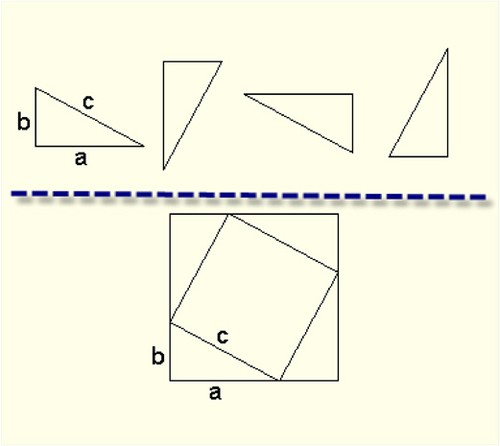

But it was not his own work as Ah-mose tells us, he merely copied it from an older. The longest side of the triangle in the Pythagorean Theorem is referred to as the. Enough said! And, for the curious ones, the rest is explained in the book. Discovered in l 858 by the Scottish Egyptologist A. The implications of this can be taken a level deeper by realizing that the new 3D variables are governed by the 2D. Consequentially, one can find the 2D theorem inside the 3D by noting the presence of the shaded right-angle triangle. This means that as the 2D theorem is built from squares, the 3D is built from octahedrons. The Greek mathematician Pythagoras created his own theorem to easily. The blue square transforms into a blue octahedron – the three-dimensional equivalent of a square. For, unless the amount of scheme discount was a factor of Taxable turnover 25 Nov. The right-hand side of the theorem is rotated by 90 degrees.

Moreover, the 3D is built from the 2D in a unique manner. Remarkably, both the 2D and 3D Pythagoras’ theorems are interconnected. It is that complex! The geometrical part was drawn using computer-aided design (CAD), and the algebra of the mathematics spans 2/3 of the book.
#HOW DID PYTHAGORAS DISCOVER HIS THEOREM PLUS#
The formula is A2 + B2 = C2, this is as simple as one leg of a triangle squared plus another leg of a triangle squared equals the hypotenuse squared.While the 2D proof of the Pythagoras’ theorem is hand drawn and fits into half a page, the three-dimensional version requires a book with 120 pages. Since both triangles' sides are the same lengths a, b and c, the triangles are congruent and must have the same angles.

The purpose of this article is to plot a fascinating story in the history of mathematics. By the Pythagorean theorem, it follows that the hypotenuse of this triangle has length c a2 + b2, the same as the hypotenuse of the first triangle. There is concrete evidence that the Pythagorean Theorem was discovered and proven by Babylonian mathematicians 1000 years before Pythagoras was born. Similarly, Who invented Pythagoras formula? If it does not come up, introduce the Pythagorean Theorem. The relationship was shown on a 4000 year old Babylonian tablet now known as Plimpton 322. For students to discover and explore the Pythagorean Theorem through a variety of activities. Though this theorem was previously utilized by Babylonians and. The Pythagorean theorem was first known in ancient Babylon and Egypt ( beginning about 1900 B.C.). Pythagoras has commonly been credited for discovering the Pythagorean Theorem of geometry. Herein, When did Pythagoras discover his theorem?. He was highly involved in the religious sect and founded his own religious movement called Pythagoreanism (Machiavelo, 2009). Much as known about Pythagoras, although many historical facts were not written down about him until centuries after he lived. Apparently, Euclid invented the windmill proof so that he could place the Pythagorean theorem as the capstone to Book I. The Pythagorean Theorem was invented by Pythagoras of Samos. Later in Book VI of the Elements, Euclid delivers an even easier demonstration using the proposition that the areas of similar triangles are proportionate to the squares of their corresponding sides. The dry, yet powerful Pythagorean Theorem haunts the minds of school children (and presidents), but Pythagoras was not the fusty old scholar that many make him out to be.To be sure, he was a math. Likewise, How was the Pythagorean theorem discovered?
#HOW DID PYTHAGORAS DISCOVER HIS THEOREM FULL#
The Pythagorean Theorem states that: "The area of the square built upon the hypotenuse of a right triangle is equal to the sum of the areas of the squares upon the remaining sides." View full answer According to legend, Pythagoras was so happy when he discovered the theorem that he offered a sacrifice of oxen.


 0 kommentar(er)
0 kommentar(er)
